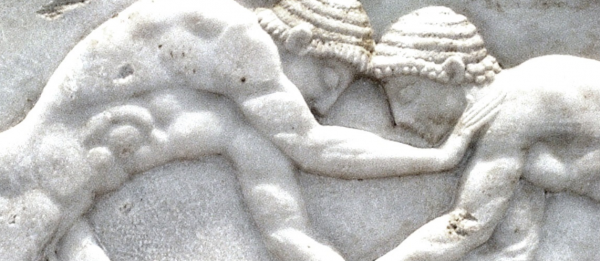Subscribe
Subscribe to our quarterly email newsletter 「ICM News」 to receive recent news about ICM, diverse writings by experts and youth, and relevant information.
Title [Martial Arts Globe] The Hero with a Thousand Holds: Exploring Our Common Grappling Heritage

|
When Japanese mixed martial arts (MMA) fighter Genki Sudo walked to the ring before his bouts, he would frequently carry a banner emblazoned with several dozen national flags and a monolithically inscribed slogan - “WE ARE ALL ONE”. And while there are of course countless facets and flavours of humanity arising out of geographic and historical circumstance, there are, incontestably, certain aspects of the human experience that we all share in common regardless of creed or colour. One of them is, without a doubt, our collective inclination towards occasionally getting together and, either for fun or for glory, attempting to fling each other to the ground. Depictions of ritualised wrestling competitions are commonplace among the artwork of ancient cultures from Egypt to Australia, and similar displays of mock combat among Great Apes suggest that it is a truly primeval activity with deep roots in our distant past. Certain scholars, in an attempt to convey the sheer breadth and depth of wrestling’s presence across human societies, have compared it to language. I would go further and argue that, as an innate instinct, it is even more universal; put a Mongolian and a German in a room and ask them to have a conversation and you won’t get far; put them in the middle of a circle of people and ask them to wrestle, and they will understand each other very clearly. Folk wrestling - that multitudinous array of grappling disciplines that have arisen everywhere from isolated Caucasian valleys to storm-scarred Patagonian shores to the dappled glades of Indonesian rainforests all throughout history - has many regional quirks and flourishes, but the core techniques, tactics, and goals remain largely the same for us all. In the latter half of 2018, I started researching these folk wrestling styles, at first simply attempting to get an overview of roughly how many such disciplines are practiced across the world. The initial result was Grappling Around the World, a map charting 74 different styles on six continents. That map - and indeed any attempt to compile a truly comprehensive list of every folk wrestling style in the world - is always destined to be incomplete, as there is simply no way to definitively determine what is still practiced where. Perhaps a style is so small and intangible that there is no record of it in any library. Perhaps a style is officially classified as extinct, but in actuality is still being practiced in a remote village somewhere. And of course, perhaps people get together and spontaneously wrestle without any kind of codified rules or agreed-upon name at all. Over the course of thousands of years, there have surely been just as many grappling “styles” that arose spontaneously around lone campfires - momentary flashes of inspiration and improvised rules that never even had names, and that ceased to exist as soon as the embers of that campfire faded and that particular group of people wandered off into the morning light. So, although I can very confidently say that there are gaps on that map, I hope it will nonetheless at least give people an idea of just how widespread wrestling is as a human activity across an incredibly diverse range of landscapes and cultures. As I built it, I gradually came to realise that I myself knew very little about the vast majority of the styles listed there. And in some cases, very little about the people and cultures that practiced them. So I was inspired to look a little bit closer. To really dive in and explore not just the rules and goals of the styles themselves, but the history, language, culture, stories, songs, battles, beliefs, sorrows, triumphs, and sometimes ultimate fates of that particular slice of humanity. A map is obviously not the best medium in which to go into that level of extended detail, so I decided to branch out and start a podcast instead. For the premier episode I looked at Irish Collar and Elbow, a now sadly extinct style that is in many ways very close to home for me, before moving on to the Yaghan of Tierra del Fuego, a people so geographically isolated that they spoke a language entirely unrelated to anything else on Earth, yet their wrestling style would have been distinctly familiar to any of us. Since I’m just back from several weeks of travelling around Southeast Asia, for the next episode I’m going to delve into Vietnamese Đấu Vật, specifically in the context of the Tết festivals that mark the Lunar New Year. ※ This writing does not reflect the opinion of UNESCO ICM. |
















